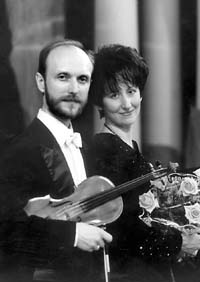Violinist, pianist, and chamber

Chamber music is true to its name, originally meaning a private performance, typically in a small hall or a person’s private chambers. With time, the notion was expanded to include public performances by small groups of performers that could be watched and heard practically everywhere. Still, the notion chamber music has over the centuries of its existence declared a conscious alternative to the music of large audiences in concert halls and city squares. The point is not only the number of performers and listeners. Chamber – or room – means a narrow chosen circle, people capable of sharing the most intimate emotions, the subtlest of nuances of perception. This is music for the chosen few and for each and everyone. In our case, it is music for the violinist and the pianist onstage, and for the listener in the audience. Because without the listener this music cannot be played. We are at a concert by the Herman Safonov and Olena Strohan duet.
They are playing Mozart’s Sonata in F Major. A harmoniously refined composition with a subtle expressiveness. The concentrated adagio might seem a little melancholic, but there is the endless flow of sparkling energy in the finale, clad in graceful movement. All bright and beautiful things have their limits; only mindlessness is infinite.
And now we are in a different, romantic world. Johannes Brahms’s first sonata for the violin and piano: a thrust, a quest, an assertion, doubts culminating in a confrontation, and a light elegy. Franz Schubert’s Sonatina No. 3 once again brings contrasting light and dark, lyricism and tragic wretchedness, and, of course, an assertion of the human ego that has a right to oppose the whole world, eulogizing the wonderful ideal, then gracefully merging into coquettish self-irony.
The Safonov-Strohan duet has existed since 1990. In 1997, they became soloists with the National Philharmonic Society of Ukraine. Their repertoire includes classical and modern compositions varying in genre and style; they have performed at such international festivals as the Kyiv Music Fest, Music Dialogues, Appolonia (Bulgaria), the Schimanowski Festival (Poland), and toured many Ukrainian and foreign cities. They seem most productive handling modern pieces. They recorded Charles Ives’s Violin Sonata No. 2 on Ukrainian Radio and it proved a highly successful experiment, for they had actually discovered the US composer for the Ukrainian audience. They play outstanding European composers practically unknown in Ukraine (like Kvandal, Bloch, Krenek) and propagate modern Ukrainian music abroad (Huba’s voluminous “Wreath of Dedications” was highly praised by Western critics).
This is probably why the best number in their recent concert at the National Philharmonic Society was Cesar Franck’s violin sonata. The French composer wrote it in the second half of the nineteenth century, but seemed to foretell with his music the impressionistic intonations of Ravel, Debussy, and even twentieth century astringent harmony. Its constant wandering amidst sensuous halftones and vague but charming contours (Part One), tragically inspired allegro (Part Two), free and impersonal recitative merging into fantasy, the musician’s impassioned confession, an expression of what is probably the only thing having a meaning. The piece ends (and so does the duet’s concert) in a cheerful allegretto poco mosso with the tragic intonations melting in an endless changing current, replaced by a new light theme. It seems to me the theme of Hope.






